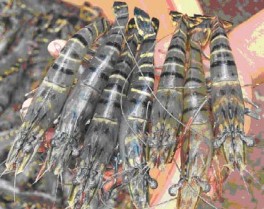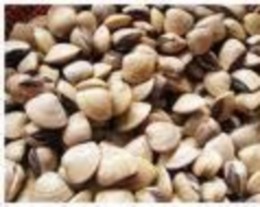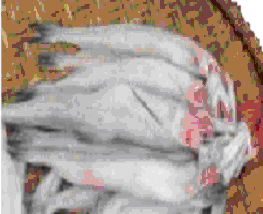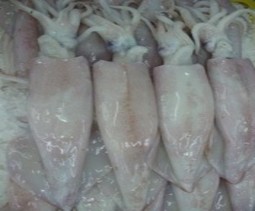48. T. Lam Michael, J. Murimboh, N.M. Hassan (2001), “Kinetic speciation of lead and cadmium in freshwaters using square-wave anodic stripping voltammetry with a thin mercury film rotating disk electrode”, Electroanalysis, Vol. 13(2), 94-99.
49. I. Clemen, M. Birringer, E. Block, J.F. Tyson (2000), “Chemical speciation influences comparative activity of selenium-enriched garlic and yeast in mammary cancer prevention”, Agric. Food Chem., Vol. 48(6), 2062-2070.
50. G. Bipra (1997), “Speciation of Cu, Cd and Pb in coastal waters of Kandla- Porbander shelf region, west coast of India”, Indian J. Mar. Sci., Vol. 26(2), 227-229.
51. Trinh Xuan Gian, Le Lan Anh, Le Duc Liem (1999), “Research on Electroanalytical Chemical methods for trace metal speciation in sea water samples”, The Fifth Asian Conference on Analytycal Sciences, Xiamen Unvsersity, Xiamen, China.
52. Trinh Xuan Gian, Trinh Anh Duc, Le Duc Liem (2000), “Electroanaytical chemical methods for determination of chemical species of lead (Pb) in seawater”, Tạp chí phân tích Hóa, Lý và Sinh học, Tập 5(4), 50- 52.
53. M. Bueno, M. Potin-Gautier (2002), “Solid-phase extraction for the simultaneous preconcentration of organic (selencystin) and inorganic [Se(IV), Se(VI)] selenium in natural waters”, Journal of Chromatography A, Vol. 963(1-2), 185-193.
54. Trinh Xuan Gian, Pham Gia Mon, Vu Duc Loi (1999), “Investigation for differrentiation of bounding strength of metals in sediments”, The Fifth Asian Conference on Analytycal Sciences, Xiamen Unvsersity, Xiamen, China.
55. E. Franco - Vietnammienne (30/10 - 03/11/2000), “Les méthodes d’analyse rapides dediées aux controle de sécurité sanitaire, Document 6: Spéciation des élements traces”, Ha Noi.
56. T. Guerin, A. Astruc, M. Astruc (1999), “Speciation of arsenic and selenium compounds by HPLC hyphenated to specific detectors: a review of the main separation techniques”, Talanta, Vol. 50(1), 1-24.
Có thể bạn quan tâm!
-
 Đường Dpcsv Xác Định Dạng Selen Trong Pha Nước Sau Khi Tách Dạng Dmdse Bằng 5,5Ml Ch 2 Cl 2
Đường Dpcsv Xác Định Dạng Selen Trong Pha Nước Sau Khi Tách Dạng Dmdse Bằng 5,5Ml Ch 2 Cl 2 -
 Sơ Đồ Chiết Tách Và Xác Định Một Số Dạng Selen Trong Mẫu Hải Sản
Sơ Đồ Chiết Tách Và Xác Định Một Số Dạng Selen Trong Mẫu Hải Sản -
 Nghiên cứu xác định một số dạng selen trong hải sản bằng phương pháp von-ampe hòa tan - 16
Nghiên cứu xác định một số dạng selen trong hải sản bằng phương pháp von-ampe hòa tan - 16 -
 Nghiên Cứu Độ Thu Hồi Của Phép Xác Định Se Tổng Trong Mẫu Chuẩn Dorm-2
Nghiên Cứu Độ Thu Hồi Của Phép Xác Định Se Tổng Trong Mẫu Chuẩn Dorm-2 -
 Nghiên cứu xác định một số dạng selen trong hải sản bằng phương pháp von-ampe hòa tan - 19
Nghiên cứu xác định một số dạng selen trong hải sản bằng phương pháp von-ampe hòa tan - 19 -
 Nghiên cứu xác định một số dạng selen trong hải sản bằng phương pháp von-ampe hòa tan - 20
Nghiên cứu xác định một số dạng selen trong hải sản bằng phương pháp von-ampe hòa tan - 20
Xem toàn bộ 165 trang tài liệu này.
57. P.C. Uden, H.T. Boakye, C. Kahakachchi, J.F. Tyson (2004), “Selective detection and identification of Se containing compounds-review and recent developments”, Journal of Chromatography A, Vol. 1050(1), 85-93.
58. E. Peacheya, K. Cookb, A. Castlesb, C. Hopleya, H. Goenaga-Infantea (2009), “Capabilities of mixed-mode liquid chromatography coupled to inductively coupled plasma mass spectrometry for the simultaneous speciation analysis of inorganic and organically-bound selenium”, Journal of Chromatography A, Vol. 1216, 7001-7006.
59. J. Zheng, M. Ohata, N. Furuta, W. Kosmus (2000), “Speciation of selenium compounds with ion-pair reversed-phase liquid chromatography using inductively coupled plasma mass spectrometry as element-specific detection”, Journal of Chromatography A, Vol. 874(1), 55-64.
60. F. Li, W. Goessler, K.J. Irgolic (1999), “Determination of trimethylselenonium iodide, selenmethionin, selenious acid, and selenic acid using high- performance liquid chromatography with on-line detection by inductively coupled plasma mass spectrometry or flame atomic absorption spectrometry” Journal of Chromatography A, Vol. 830(2), 337-344.
61. G. Kölbl (1995), “Concepts for the identification and determination of selenium compounds in the aquatic environment”, Marine Chemistry, Vol. 48(3-4), 185-197.
62. L. Orero Iserte, A.F. Roig-Navarro, F. Hernández (2004), “Simultaneous determination of arsenic and selenium species in phosphoric acid extracts of sediment samples by HPLC-ICP-MS”, Analytica Chimica Acta, Vol. 527(1), 97-104.
63. X.C. Le, X.F. Li, V. Lai, M. Ma, S. Yalcin, J. Feldmann (1998), “Simultaneous speciation of selenium and arsenic using elevated temperature liquid chromatography separation with inductively coupled plasma mass spectrometry detection”, Spectrochimica Acta Part B: Atomic Spectroscopy, Vol. 53(6-8), 899-909.
64. A. Chatterjee, H. Tao, Y. Shibata, M. Morita (2003), “Determination of selenium compounds in urine by high-performance liquid chromatography– inductively coupled plasma mass spectrometry”, Journal of Chromatography A, Vol. 997(1-2), 249-257.
65. S. McSheehy, W. Yang, F. Pannier, J. Szpunar, R. Łobi´nski, J. Auger, M. Potin-Gautier (2000), “Speciation analysis of selenium in garlic by two- dimensional high-performance liquid chromatography with parallel inductively coupled plasma mass spectrometric and electrospray tandem mass spectrometric detection”, Analytica Chimica Acta, 421, 147-153.
66. M. Shah, S.S. Kannamkumarath, J.C.A. Wuilloud, R.G. Wuilloud and J.A. Caruso (2004), “Identification and characterization of selenium species in enriched green onion (Allium fistulosum) by HPLC-ICP-MS and ESI-ITMS”,
J. Anal. At. Spectrom., Vol. 19, 381-386.
67. A. Chatterjee, Y. Shibata, M. Morita (2001), “Determination of selenmethionin by high performance liquid chromatography-direct hydride generation-atomic absorption spectrometry” Microchemical Journal, Vol. 69(3), 179-187.
68. C. Cámara, R. Cornelis, P. Quevauviller (2000), “Assessment of methods currently used for the determination of Cr and Se species in solutions”, TrAC Trends in Analytical Chemistry, Vol. 19(2-3), 189-194.
69. I. Ipolyi, P. Fodor (2000), “Development of analytical systems for the simultaneous determination of the speciation of arsenic [As(III), methylarsonic acid, dimethylarsinic acid, As(V)] and selenium [Se(IV), Se(VI)] Analytica Chimica Acta, 413, 13-23.
70. I. Ipolyi, Zs. Stefánka, P. Fodor (2001), “Speciation of Se(IV) and the selenoamino acids by high-performance liquid chromatography-direct hydride generation-atomic fluorescence spectrometry”, Analytica Chimica Acta, 435, 367-375.
71. P. Viđas, I. López-García, B. Merino-Merođo, N. Campillo, M. Hernández- Córdoba (2005), “Determination of selenium species in infant formulas and dietetic supplements using liquid chromatography-hydride generation atomic fluorescence spectrometry”, Analytica Chimica Acta, Vol. 535(1-2), 49-56.
72. G.E. Batley (1986), “Differential-pulse polarographic determination of selenium species in contaminated waters”, Analytica Chimica Acta, Vol. 187, 109-116.
73. P.C. do Nascimento, C.L. Jost, L.M. de Carvalho, D. Bohrer, A. Koschinsky (2009), “Voltammetric determination of Se(IV) and Se(VI) in saline samples- Studies with seawater, hydrothermal and hemodialysis fluids. Analytica Chimica Acta, Vol. 648(2), 162-166.
74. Lê Đức Liêm (2004), “Nghiên cứu xác định hàm lượng và dạng tồn tại vết Chì (Pb) và Đồng (Cu) trong nước biển bằng phương pháp Von-Ampe hòa tan ”, Luận án tiến sĩ Hóa học, Viện Hóa học - Viện KH & CN Việt Nam, Hà Nội.
75. J.L. Gosmez-Ariza, J.A. Pozas, I. Giráldez, E. Morales (1998), “Speciation of volatile forms of selenium and inorganic selenium in sediments by gas chromatography-mass spectrometry”, Journal of chromatography A, Vol. 823(1-2), 259-277.
76. K. Pyrzynska (2001), “Analysis of Selenium Species by Cappillary Electrophoresis”, Talanta, Vol. 55, 657-667.
77. N. Gilon, M. Potin-Gautier (1996), “Cappillary Electrophoresis applied to the determination of some seleno compounds”, Journal of Chromatography A, Vol. 732, 369-376.
78. J. Wang (1994), “Analytical electrochemistry”, VCH Publishers, Inc-New York, USA.
79. Từ Vọng Nghi, Trần Trương Huyến, Phạm Luận (1990), “Một số phương pháp phân tích điện hóa hiện đại”, Trương trình hợp tác KHKT Việt Nam - Hà Lan, Đề tài VH2, Hà Nội.
80. Lê Lan Anh (1993), “Nghiên cứu phương pháp Von-Ampe điện lượng hòa tan ứng dụng kỹ thuật vi tính xác định vết kim loại nặng trong một số đối tượng môi trường”, Luận án phó tiến sĩ Hóa học, Viện Hóa học-Viện Khoa học Việt Nam, Hà Nội.
81. Từ Vọng Nghi (1990), “Các phương pháp phân tích điện hóa hòa tan”, ĐHQG Hà Nội, Tr. 20-25.
82. Nguyễn Việt Huyến (1999), “Cơ sở các phương pháp phân tích điện hóa”,
ĐHQG Hà Nội, Tr. 172-183.
83. Trần Tứ Hiếu, Từ Vọng Nghi, Nguyễn Văn Ri, Nguyễn Xuân Trung (2003), “Hóa học Phân tích-Phần 2: Các phương pháp phân tích công cụ”, ĐHQG Hà Nội, Tr. 107-143.
84. Trần Chương Huyến, Lê Thị Hương Giang, Nguyễn Minh Quý (2009), “Điện cực paste cacbon biến tính bằng HgO và ứng dụng trong phân tích Von-Ampe hòa tan, Phần 1: Chế tạo điện cực và các đặc trưng điện hóa của điện cực”, Tạp chí Phân tích Hóa, Lý và Sinh học, Tập 14(3), 3-6.
85. Trần Chương Huyến, Lê Thị Hương Giang (2010), “Điện cực than mềm biến tính bằng HgO và ứng dụng trong phân tích Von-Ampe hòa tan, Phần 4: Xác định selen bằng phương pháp Von-Ampe hòa tan catot trên điện cực than mềm biến tính bằng HgO”, Tạp chí Phân tích Hóa, Lý và Sinh học, Tập 15(4), 270-275.
86. T. Ferri, G. Favero, M. Frasconi (2007), “Selenium speciation in foods: Preliminary results on potatoes”, Microchemical Jounal, 85, 222-227.
87. C. Elleouet, F. Quentel and C. Madec (1996), “Determination of inorganic and organic selenium species in natural waters by cathodic stripping voltammetry”, Wat. Res., Vol. 30(4), 909-914.
88. Ruoh-Yun Wang, Ying-Ling Hsu, Lan-Fang Chang, Shiuh-Jen Jiang (2007), “Speciation analysis of arsenic and selenium compounds in environmental and biological samples by ion chromatography–inductively coupled plasma dynamic reaction cell mass spectrometer”, Analytica Chimica Acta, Vol. 590(2), 239-244.
89. G. Önning (2000), “Separation of soluble selenium compounds in different fish species”, Food Chemistry, Vol. 68(2), 133-139.
90. B. Åkesson, T.S. Srikumar (1994), “Occurrence of low-molecular-weight and high-molecular-weight selenium compounds in fish”, Food Chemistry, Vol. 51(1), 45-49.
91. Đỗ Quang Trung (2002), “Ứng dụng nhựa vòng càng trong phương pháp chiết pha rắn để tách làm giàu nhằm xác định lượng vết Thủy ngân và Asen trong môi trường nước”, Luận án tiến sĩ Hóa học, Trường ĐHQG Hà Nội, Hà Nội.
92. Vũ Đức Lợi (2008), “Nghiên cứu xác định một số dạng Thủy ngân trong các mẫu sinh học và môi trường”, Luận án tiến sĩ Hóa học, Viện Hóa học-Viện KH & CN Việt Nam, Hà Nội.
93. Nguyễn Đình Thuất (2008), “Nghiên cứu phân tích liên tục (on-line) dạng Asen trong một số đối tượng môi trường biển bằng phương pháp liên hợp sắc kí lỏng và hấp thụ nguyên tử”, Luận án tiến sĩ Hóa học, Viện Hóa học-Viện KH & CN Việt Nam, Hà Nội.
94. Nguyễn Đình Thuất, Bùi Minh Lý, Phạm Đức Thịnh, Lê Lan Anh (2007), “Nghiên cứu phân tích dạng asen trong rong biển bằng phương pháp liên hợp sắc kí lỏng hiệu năng cao-quang phổ hấp thụ nguyên tử”, Tạp chí Hóa học, Tập 45(6A), 250-256.
95. Lê lan Anh, Nguyễn Đình Thuất, Bùi Minh Lý, Phạm Đức Vinh (2007), “Phân tích dạng asen trong nước và trầm tích ven biển bằng kĩ thuật ghép nối sắc kí lỏng hiệu năng cao và quang phổ hấp thụ nguyên tử”, Tạp chí Hóa học, Tập 45(6A), 263-268.
96. Vũ Đức Lợi, Trịnh Anh Đức, Nguyễn Hưng Dũng, Trịnh Hồng Quân, Nguyễn Hồng Hà, Trịnh Thu Hà, Phạm Gia Môn, Nguyễn Thị Trang, Dương Thị Tú Anh (2010), “Phân tích dạng Crom trong trầm tích lưu vực sông Nhuệ và Đáy”, Tạp chí phân tích Hóa, Lý và Sinh học, Tập15(4), 34-40.
97. Vũ Đức Lợi, Nguyễn Thanh Nga, Trịnh Anh Đức, Phạm Gia Môn, Trịnh Hồng Quân, Dương Tuấn Hưng, Trần Thị Lệ Chi, Dương Thị Tú Anh (2010), “Phân tích dạng một số kim loại nặng trong trầm tích thuộc lưu vực sông Nhuệ và sông Đáy”, Tạp chí phân tích Hóa, Lý và Sinh học, Tập15(4), 26-33.
98. Lê Lan Anh, Vũ Đức Lợi, Trịnh Anh Đức, Nguyễn Thị Hương Giang, Nguyễn Thị Minh Lợi (2010), “Nghiên cứu phân tích dạng Crom (Cr), Cadimi (Cd) và Chì (Pb) trong đất trồng trọt”, Tạp chí phân tích Hóa, Lý và Sinh học, Tập 15(3), 222-227.
99. Tiêu chuẩn Quốc gia: TCVN 5276:1990 (2010), “Thủy sản-Lấy mẫu và chuẩn bị mẫu”, Hà Nội.
100. Dr. Phạm Luận (1999), “Giáo trình hướng dẫn về những vấn đề cơ sở của các kỹ thuật xử lý mẫu phân tích”, Nhà xuất bản ĐHQG Hà Nội, Hà Nội.
101. Từ Vọng Nghi (2009), “Hóa học phân tích-Phần 1:Cơ sở lí thuyết các phương pháp Hóa học phân tích”, Nhà xuất bản ĐHQG Hà Nội, Hà Nội, Tr. 296-312.
102. Hoàng Minh Châu, Từ Văn Mặc, Từ Vọng Nghi (2002), “Cơ sở Hóa học phân tích”, Nhà xuất bản KH & KT, Hà Nội, Tr. 191-201.
103. Đinh Thị Trường Giang (2011), “Nghiên cứu phương pháp Von-Ampe hòa tan hấp phụ để xác định vết cadimi, kẽm và selen”, Luận án tiến sĩ Hóa học, Viện Hóa học-Viện KH & CN Việt Nam, Hà Nội.
104. Đặng Văn Khánh (2008), “Nghiên cứu phát triển và ứng dụng điện cực màng bismut để xác định vết chì và cađimi trong một số đối tượng môi trường”, Luận án tiến sĩ Hóa học, Trường ĐHQG Hà Nội, Hà Nội.
105. M. Somenath (2003), “Sample preparation techniques in analytical chemistry”,
John Wiley & Sons, Inc., Hoboken, New Jersey, USA.
106. Sakura Yoshida, Mamoru Haratake, Takeshi Fuchigami, and Morio Nakayama (2011), “Selenium in Seafood Materials”, Journal of Health Scien, Graduate School of Biomedical Sciences, Nagasaki University, Vol 57(3), 215-224.
PHỤ LỤC
1.Một số hình ảnh của mẫu hải sản nghiên cứu


Hình 1: Mẫu Tôm Hình 2: Mẫu Ngao


Hình 4: Mẫu cá Khoai Hình 5: Mẫu Mực

Hình 6: Mẫu cá Thu






